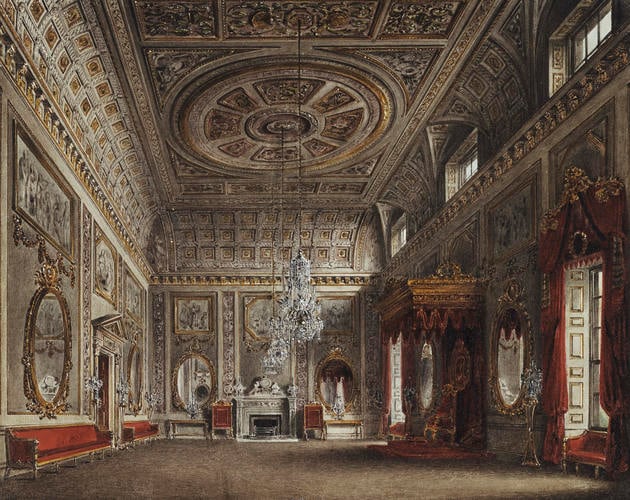James Stephanoff (1789-1874)
Buckingham House: The Saloon 1818
Watercolour and bodycolour over pencil | 21.0 x 25.1 cm (sheet of paper) | RCIN 922141
-
The Saloon was the largest room in Buckingham House and occupied the first and second floor in the centre of the entrance front of the house, immediately above the Entrance Hall. George III’s works in the 1760s may have involved a complete reconstruction of this room: as shown in this view, it is the work of a combination of the King’s architects - Robert Adam, William Chambers, John Yenn and probably also James ‘Athenian’ Stuart.
The room was evidently in a fit state to receive the seven vast Raphael Cartoons from Hampton Court in 1763. They were described in the Saloon by Horace Walpole in 1783, hanging edge to edge on all except the window wall, with ‘light green Damask’ below. Cipriani’s finely detailed ceiling, possibly designed by James Stuart, was presumably in place by 1763; it replaced one painted by Laguerre. The chimneypiece on the north wall was designed by Robert Adam; it was included in his Works in Architecture with the date 1761. Adam’s design for a massive doorway, flanked by Ionic columns, may have been intended for the opening on the left leading to the Crimson Drawing Room.
After the Raphael Cartoons were removed in 1787 (to be taken first to Windsor, then back to Hampton Court), the walls of the Saloon were decorated in the manner shown here. Elevations for the new decorative scheme were supplied by John Yenn.
Stephanoff’s view also records the furnishings supplied in 1799 by the carver and gilder William Adair: six large sofas and three small ones (for the window bays). These were originally covered with white cotton velvet, painted with flowers by Princess Elizabeth. Further changes were made after the fire at St James’s Palace in 1809, the declaration of the Regency in 1811 and Parliament’s decision in 1812 to grant Queen Charlotte her own establishment, including income for the upkeep of Buckingham House. A number of the formal receptions previously held at St James’s were now transferred to Buckingham House, hence the presence of the fine canopied throne in the Saloon. New upholstery (in red) was introduced at the same time.
The site of George III’s Saloon is now occupied by Nash’s Green Drawing Room. The chimneypiece, still surmounted by the same white marble clock - with figures of Vigilance and Patience, carved by John Bacon the elder in 1789 - is now in the Queen’s Presence Chamber at Windsor Castle.
Catalogue entry adapted from George III & Queen Charlotte: Patronage, Collecting and Court Taste, London, 2004Provenance
Probably acquired by George IV
-
Creator(s)
Acquirer(s)
-
Medium and techniques
Watercolour and bodycolour over pencil
Measurements
21.0 x 25.1 cm (sheet of paper)
Other number(s)
RL 22141Alternative title(s)
[The Saloon at Buckingham House]










